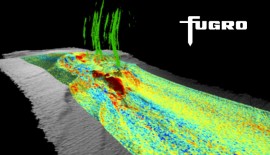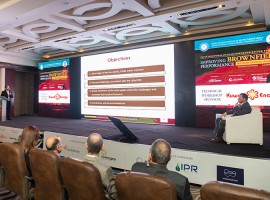Apollonia formation forms a reasonable reservoir size spreading over an area of several hundred kilometers and it is characterized as a carbonate reservoir that consists mainly of high-porosity soft chalky and low permeability limestone.
Commercial discovery of the Apollonia formation in the JD field was in 2008 by Shell, with first gas from vertical wells in 2012.Production of the tight-gas Apollonia formation from the fractured vertical wells was uneconomical. This trigged the idea of Egypt’s first unconventional oil and gas project in the Apollonia JD field back in December 2014, when the Egyptian General Petroleum Corporation (EGPC), Apache, and Royal Dutch Shell signed a $40 million deal to start exploring unconventional gas in Abu Al-Gharadeeq region in the Western Desert of Egypt, about 200 km west of Cairo. A Pilot was designed to apply existing North America tight-gas technology in Egypt. Such technology is a first application in Egypt with an objective to economically develop the difficult gas from the unconventional Apollonia play. As a result of careful planning and design work with the operators, the execution of deploying multi-stage propped sand fractures in a long reach horizontal well of some 1000m was deemed a success.
The pilot phase was to be carried out by Khalda Petroleum Company, a joint venture (JV) of Apache. A service provider company, Schlumberger, was also involved in collaboration from the beginning in all the planning efforts, leveraging advanced technical workflows. Through several conference calls, meetings, and presentations both internally within Schlumberger, and externally with Khalda, Apache and all the involved parties have been discussing the most suitable technologies applicable for such an unconventional horizontal multistage hydraulic fracturing completion.
The project started with drilling two experimental data wells in Apollonia field with the aim to collect field core samples as well as record the logging suit. That, combined together with the advanced core testing performed in the TerraTek Salt Lake City lab, in addition to reservoir modeling and heterogeneity analysis helped the parties understand complex mineralogy, variable rock fabric, and mechanical properties. The combination of reservoir quality and completion quality contributed to the application of the most appropriate drilling, completion, and production strategies.
Building on the success of both Apache and Schlumberger in unconventional plays in the US the companies utilized the plug and perf technique in horizontal wells multistage stimulation, as a technique of choice in such an early phase of the project. As this kind of operation has not been performed in Egypt before and water required as a base of the fracturing fluid would be around 3.5 million gallons per well, this huge amount would be sufficient for two days of drinking in Dallas or enough for eight hours in Beijing, having to haul this amount of water would tremendously impair the efficiency of such project. Hence, in preparation of the project, Khalda and Apache drilled a water source well in close proximity to the horizontal well location to provide water for the fracturing operations. Meanwhile, Schlumberger Fracturing Technical team worked on optimizing fracturing fluid formulation to fit the use of the formation water, instead of the use of fresh water for the Frac fluid.
Schlumberger Egypt Team, integrated the resources and technologies from several product lines and affiliated companies for this operation, that included Filtration services from MiSWACO, FracStack from Cameron group to accommodate the high rate plug and perf Fracturing operations, 2 inch Coiled Tubing deployed wireline guns for multi-cluster perforation and simultaneous setting of bridge plugs, and 2 inch conventional Coil Tubing for sand cleanout and post Frac Nitrogen lifting. In addition, Schlumberger brought Fracturing Equipment that is used for the first time in Egypt operations such as the Precision Continuous Mixing (PCM), to enable treatment on fly with a pumping rate up to 70 bpm and more than 50,000 bbls in one well, in less than 10 days, hence, exceeding client’s expectations and benchmark performance by at least one week. All this was combined with a fully comprehensive HSE plan in coordination with Khalda’s and Apache’s HSE Teams to minimize and mitigate all related risks.
Three month before the project was launched, a rigid project schedule was in place to account for any changes in client’s requirements. Subsequently, the client held weekly meetings with its partners to follow on equipment readiness, various resources availability, and project execution plan. In parallel, several meeting were conducted with Khalda’s and Apache’s Engineering teams to discuss various design aspects and strategies with the help of both Khalda Reservoir team and Schlumberger. Accordingly, Schlumberger was able to model fracturing simulation utilizing the mangrove workflow over the actual petrel reservoir model from Khalda, which enabled the service provider to select the optimum spacing between stages as well as perforation clusters based on reservoir and completion quality and breakdown pressure.
In terms of execution, Schlumberger deployed the bulk system for loading more than 600,000 lbs of sand per stage into sand chiefs, which saved more than 18 working hours per stage, compared to the conventional method of using crane for sand loading. This method also minimized HSE risks on location and allowed loading into different sand chiefs or compartments simultaneously as required. The use of precision continuous mixing (PCM) as well as liquid clay stabilizer, instead of the conventional KCL, allowed enhancing efficiency. Moreover, the technique further enabled continuous mixing and pumping on the fly, filling tanks directly from the frac pit while pumping, eliminating the need for batch mixing, and tackling any risks related to bacterial activity.
Schlumberger supported the project with a fully operational man camp and a clinic as well. Accordingly, client’s feedback during all project phases as well as after the project completion was that Schlumberger’s integration, state-of-the-art workflow, excellent service delivery, service quality, and HSE performance jointly exceeded all client’s expectations in terms of the project schedule and execution timeline in comparison to established benchmarks.
The integration strategy employed from the start of the project, along with the performance excellence in every stage of the project, resulted in stabilized gas production of 7 MMscf/d of gas after 120 days of well production. The production rate is equivalent to five times the offset vertical well off take of around 1-2 MMscf/d; whilst the initial gas production rate is encouraging, the long term success is still under investigation. Some 18-24 months of production performance history is typically required to assess the feasibility of the technology, which if proven would mean long term economic production and higher cumulative recovery in a shorter period of time.
Hence, the partners have succeeded to turn Apollonia pilot phase into an exclusive example of advanced integrated workflows, and through heterogeneity analysis have optimized the unconventional horizontal multistage hydraulic fracturing completion design and efficiency. This has opened the way to further develop the Apollonia chalk towards successful production for Egypt.







